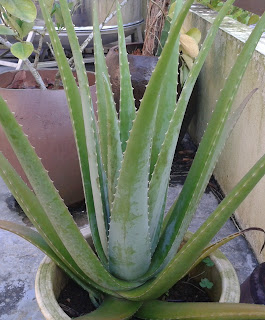Aloe Vera
http://en.wikipedia.org/wiki/Aloe_vera
Claims of medical properties

Aloe vera gel being used to make a dessert.
Scientific evidence for the cosmetic and therapeutic effectiveness of aloe vera is limited and when present is frequently contradictory.
[2][3] Despite this, the cosmetic and alternative medicine industries regularly make claims regarding the soothing, moisturizing, and healing properties of aloe vera, especially via Internet advertising.
[4][39][40][41][42] Aloe vera gel is used as an ingredient in commercially available
lotions,
yogurt,
beverages, and some
desserts.
[43][44][45]
Aloe vera juice is used for consumption and relief of digestive issues such as
heartburn and
irritable bowel syndrome, although it bears significant potential to be toxic when taken orally.
[46] It is common practice for cosmetic companies to add sap or other derivatives from
Aloe vera to products such as
makeup,
tissues,
moisturizers,
soaps,
sunscreens,
incense,
shaving cream, and
shampoos.
[43] Other uses for extracts of aloe vera include the dilution of
semen for the artificial fertilization of sheep,
[47] use as fresh food preservative,
[48] and use in
water conservation in small farms.
[49] The supposed therapeutic uses of
Aloe vera are not exclusive to the species and may be found to a lesser or greater degree in the gels of all aloes, and indeed are shared with large numbers of plants belonging to the family
Asphodelaceae.
Bulbine frutescens, for example, is used widely for the treatment of burns and a host of skin afflictions.
[50]
Aloe vera has a long association with
herbal medicine, although it is not known when its medical applications were first suspected. Early records of
Aloe vera use appear in the
Ebers Papyrus from 16th century BC,
[16] in both
Dioscorides' De Materia Medica and
Pliny the Elder's Natural History written in the mid-first century CE
[16] along with the
Juliana Anicia Codex produced in 512 AD.
[43] Aloe vera is non-toxic, with no known side effects, provided the
aloin has been removed by processing. Taking aloe vera that contains
aloin in excess amounts has been associated with various side-effects.
[4][5][51] However, the species is used widely in the traditional herbal medicine of
China,
Japan,
Russia,
South Africa, the
United States, Jamaica, Latin America and
India.
[4]
Aloe vera may be effective in treatment of wounds.
[5] Evidence on the effects of its sap on wound healing, however, is limited and contradictory.
[5] Some studies, for example, show that aloe vera promotes the rates of healing,
[52][53] while, in contrast, other studies show that wounds to which aloe vera gel was applied were significantly slower to heal than those treated with conventional medical preparations.
[54][55] A more recent review (2007) concludes that the cumulative evidence supports the use of aloe vera for the healing of first to second degree burns.
[56] In addition to topical use in wound or burn healing, internal intake of aloe vera has been linked in preliminary research with improved blood
glucose levels in
diabetics,
[57][58] and with lower blood
lipids in
hyperlipidaemic patients,
[59] but also with acute hepatitis (liver disease).
[51] In other
diseases, preliminary studies have suggested oral aloe vera gel may reduce symptoms and inflammation in patients with
ulcerative colitis.
[60] Compounds extracted from aloe vera have been used as an
immunostimulant that aids in fighting cancers in cats and dogs;
[6] however, this treatment has not been scientifically tested in humans.
Topical application of aloe vera may be effective for
genital herpes and
psoriasis.
[61] However, it is not effective for the prevention of radiation-induced injuries. Although anecdotally useful, it has not been proven to offer protection from sunburn or suntan.
[62] In a
double-blind clinical trial, both the group using an aloe vera containing
dentifrice and the group using a fluoridated dentifrice had a reduction of gingivitis and plaque, but no statistically significant difference was found between the two.
[63]
Aloe vera extracts might have
antibacterial and
antifungal activities, which possibly could help treat minor skin infections, such as
boils and benign skin
cysts and may inhibit growth of fungi causing
tinea.
[64] For bacteria, inner-leaf gel from aloe vera was shown in one study to inhibit growth of
Streptococcus and
Shigella species in vitro.
[65] In contrast,
aloe vera extracts failed to show antibiotic properties against
Xanthomonas species.
[66]
Side Effects and Cautions
Use of topical aloe vera is not associated with significant side effects. A 2-year National Toxicology Program (NTP) study on oral consumption of non-decolorized whole leaf extract of aloe vera found clear evidence of
carcinogenic activity in male and female rats, based on tumors of the large intestine. According to the NTP, from what is known right now there is nothing that would lead them to believe that these findings are not relevant to humans. However, more information, including how individuals use different types of aloe vera products, is needed to determine the potential risks to humans.
Abdominal cramps and
diarrhea have been reported with oral use of aloe vera. Diarrhea, caused by the laxative effect of oral aloe vera, can decrease the absorption of many drugs. People with diabetes who use glucose-lowering medication should be cautious if also taking aloe by mouth because preliminary studies suggest aloe may lower blood glucose levels. There have been a few case reports of acute
hepatitis from aloe vera taken orally. However, the evidence is not definitive.
[71]



